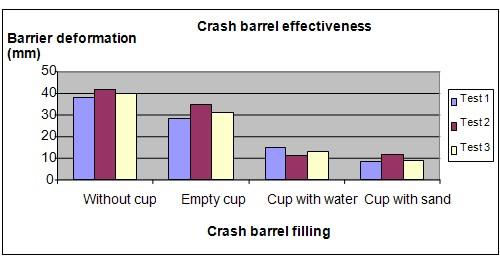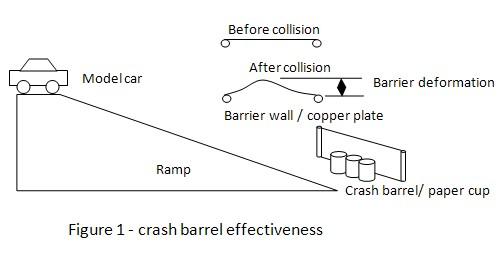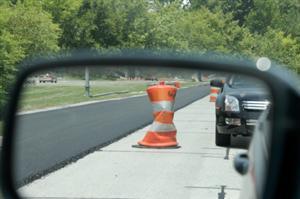| Complexity level: | 7 |
| Project cost ($): | 20 |
| Time required: | 1 hour to prepare, 1 day for experiment |
| Material availability: | Easily found |
| Safety concerns: | None |
Hypothesis
Paper cups filled with water and sand will be able to absorb a greater amount of impact during a collision.
Overview
Crash barrels
Crash barrels or impact attenuators are devices that help to reduce the damage to vehicles and roadside structures in the event of a collision. They help in absorbing and dissipating the kinetic energy from the colliding vehicle.
Normally crash barrels are brightly colored plastic containers filled with water or sand in . They are placed along the highway, sharp corners or in places where the risk of accidents is high. They are also used for redirecting traffic or to protect roadside workers and equipment.
During a collision with a crash barrel filled with sand, the kinetic energy of the vehicle is absorbed by the barrel and dissipated by the scattering of the sand. Similarly the crash barrel filled with water will dissipate the kinetic energy by the gushing out of water from the barrel. The colliding vehicle will slow down as kinetic energy is transferred to the crash barrel. A violent crash and injury to the occupants of the vehicle can then be avoided.
Scientific Terms
Materials
The materials required for this science project:
- A ramp (at least 2 meters long)
- 3 empty paper cups
- 3 paper cups filled with water
- 3 paper cups filled with sand
- A model car
- 12 plates of copper (50mm x 400mm x 0.2mm thickness)
- 2 long nails ( more than 60mm long)
- 1 ruler
- 1 roll of masking tape
Procedure
1. For this experiment, the independent variable is the filling in the paper cup/crash barrel – empty, water, or sand. The dependent variable is the deformation on the copper barrier. This is determined by measuring the deformation with a ruler. The constants (control variables) are the degree of elevation of the ramp, the length of the ramp, the surface condition of the ramp, weight of the car and size of the paper cups.

2. The science experiment is set up as shown in figure 1 above. The model car is placed on top of the ramp. The nails are hammered to the floor, about 300mm from the bottom of the ramp. The copper plate which will act as a barrier wall is bent and fixed to the nails with scotch tape. The paper cups which represent the crash barrels are placed in front of the copper plate.
3. The experiment is first done without any paper cups. The car is released from the top of the ramp and the deformation of the copper plate is measured. The copper plate is replaced and the test is done a total of 3 times. The measurements are recorded in the table below.
4. Procedure 3 is repeated by placing 3 empty paper cups in front of the copper plate. The measurements are again recorded in the table below.
5. Procedure 3 is repeated using 3 paper cups filled with water and another using three cups filled with sand. The results are all recorded in the table below.


Results
The results show that the cups filled with water and sand are able to absorb more impact from the collision, than the empty cups. Deformation of the copper plate was at its greatest, with the empty cups.
|
Barrier deformation of copper plate (mm) |
||||
|
Without cup |
Empty cup |
Cup with water |
Cup with sand |
|
|
Test 1 |
38 |
28 |
15 |
8 |
|
Test 2 |
42 |
35 |
11 |
12 |
|
Test 3 |
40 |
31 |
13 |
9 |
The chart below represents the results of our science project experiment.

Conclusion
The hypothesis that paper cups filled with water and sand will be able to withstand a greater impact due to collision, is proven to be true.
Crash barriers have been used in the USA since the 1960s and are believed to have helped save over 15,000 lives. They are very effective and popular. They don't cost very much and are very easy to set up. The repair and replacement of the crash barriers are also very simple.
Also consider
You could try to ascertain which is a better impact absorber - water or sand? What about foam, or clay, or compressed air?
Try to repeat the experiment by raising the ramp gradient in order to increase the speed of the car. Then see which is more effective.
References
Impact attenuator - http://en.wikipedia.org/wiki/Impact_attenuator
A crash barrier of crumpled sheet metal - http://www.science-projects.com/Crumple.htm

